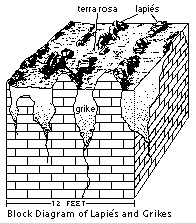Lapiés, Grikes and Terra Rosa
 When limestone is disintegrated by solutional processes, it leaves behind a clayey, residual soil known as terra rosa (Latin for "red earth"). Terra rosa is characteristic of much of the Mitchell Plain, where these processes have been taking place for hundreds of thousands of years.
When limestone is disintegrated by solutional processes, it leaves behind a clayey, residual soil known as terra rosa (Latin for "red earth"). Terra rosa is characteristic of much of the Mitchell Plain, where these processes have been taking place for hundreds of thousands of years.
 Where erosion has removed the overlying soil , the limestone bedrock can be seen. On some of these surfaces and elsewhere in the near- surface limestone, joints are opened and widened into fissures known as grikes (see the diagram at left). The rounded, upward- projecting surfaces of the remaining limestone are known as lapiés.
Where erosion has removed the overlying soil , the limestone bedrock can be seen. On some of these surfaces and elsewhere in the near- surface limestone, joints are opened and widened into fissures known as grikes (see the diagram at left). The rounded, upward- projecting surfaces of the remaining limestone are known as lapiés.
Pictured is a classic example of these solution features just west of the Monon railroad cut a few miles south of Bedford, Indiana. The features in this vicinity were the subject of a 1948 paper by geologist Preston McGrain for the Indiana Academy of Sciences. Note the color of the terra rosa soil. Similar features may be seen near the large quarry north of the town of Oolitic.
Diagram modified from R Powell / Indiana Geological Survey

